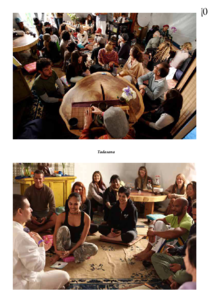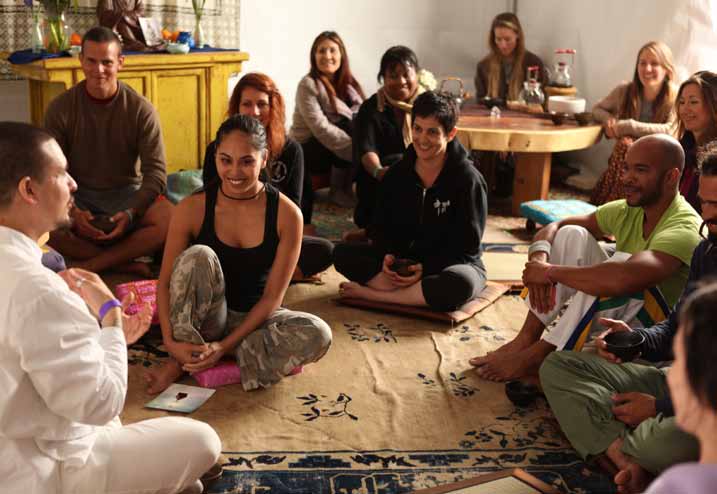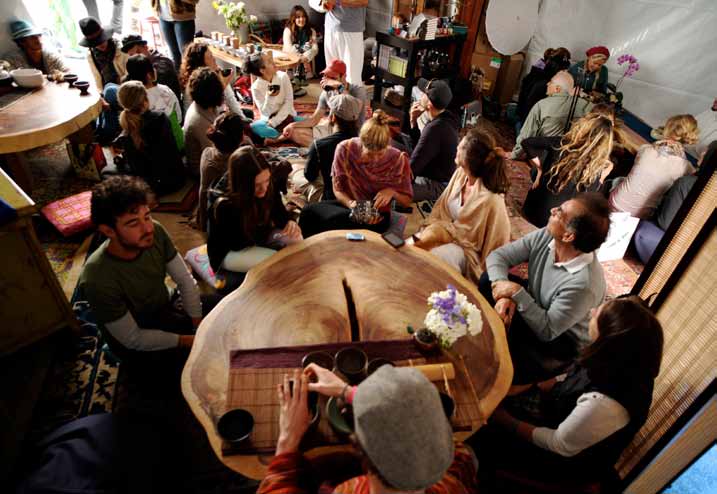
 |
|
To know harmony is to know the Eternal, To know the Eternal is to cultivate insight.
Harmony through alchemy has always been central to the aesthetics and philosophy of tea culture, whether clearly expressed by ancient Daoist mendicants, or left unstated, yet recognized by the modern tea drinker who intuitively knows when a tea set functions well, when a tea is brewed properly, or when something in the process is off. The mixing and blending of figurative and material elements in tea truly is alchemical - both externally in the way the leaf, water, fire and teaware combine to form the liquor; and internally in the way we use the tea session to create peace, quiet and a stillness that inspires dialogue with Nature and the Dao. And harmony has always been the guiding principle of these processes, for it is the harmony of a tea set that makes it beautiful and functional, the harmony of a tearoom which inspires relaxation, and even the harmony of the leaf, water and teaware which combines to make the best liquor. In the exploration of tea and our own development towards mastery, harmony is the ideal that we must seek out, just as masters past and present have always done.
The best teas are those which are brewed in a place where all the elements are in harmony together. This needn't mean anything magical or difficult to understand: "harmony" might just refer to the way that the proper water, at the proper temperature, combines with the right kind of leaves in the right amount, all in the best teaware, etc. What could be more alchemical? More and more modern tea farmers, artists that craft teaware, and even tea drinkers are beginning to understand that harmony must guide their tea. In exploring the elements that go into a fine cup of tea, and the way in which a more harmonious approach can be achieved, we can learn not only how to develop and progress in Cha Dao, but how tea can be a part of a healthier, calmer and more productive lifestyle.
Since ancient times Chinese sages and seers have separated the material world into five elements called "Wu-shing (五行)": wood, earth, water, fire, and metal. These principal elements are extremely complicated, influencing all aspects of Chinese culture, philosophy and spirituality - from Daoism to Buddhism, Feng-shui, medicine and even tea. Lu Yu himself inscribed symbols representing the Wu-shing on all of his teaware, and spoke of the way they all combined fluently in the brewing of tea.
Traditionally, these elements represented much more than just material aspects of the universe. They were also processes, with fire representing temperature and earth representing yin energy for example, and much more. They guided the selection and construction of buildings, understanding of the seasons and agriculture, spiritual work and meditation as well as Chinese medicine.
For tea brewing, it isn't important that one understand the library of concepts and ideas behind the Wu-shing or even recognize all of the phenomena that these concepts refer to as they occur in Nature. In order to grow in tea and develop in Cha Dao, we only need to understand how each of these elements combine to make the greatest cup of tea, and the way they come together in our spirits so that drinking fine tea daily can become more than just a beverage or refreshment, but a Way of living in concordance with ourselves, with nature and ultimately with each other as well.
As an ongoing column, I thought that each issue we could explore one of the Wu-shing as it pertains to Cha Dao. One should remember that the elements flow in and through each other, so the earth and water are in the wood, the fire in the water, etc., and we're just separating them conceptually for the sake of discussion. In understanding each of these elements, we might begin to see how they can either make or break the overall harmony of our tea session and our approach to tea as a time for relaxation, quiet, insight or even just the desire to share good tea with family and friends. Last issue, we started at the source of all tea: Water. Let us now turn to Fire...

Fire is the energy at the center of our universe and our civilization. The stars of fire fill our sky and remind us of how vast a world we live in. And their nearest kin, our sun, lights our world and courses through all that we do. Even our technology is fueled by solar energy, fossil or renewable. Ancient people knew to respect the sun, and its relationship in our lives. As our sky is filled with the fire of so many suns, so too is our own Mother Earth pregnant with a deep, burning warmth. That warmth has nurtured all life on this planet as much as the sunlight that enlivens us from without.
Without heat nothing moves. Tea, like all plants, translates sunlight and starlight into Wood - into physical substances we can touch and taste, smell and drink. Through the plants, we absorb sun energy and motivate our bodies. The temperature in our bodies is a measurement of life itself, and consequently so many of our metaphors regarding death contain variations of the word "cold". Internally, so many of our bodily and spiritual processes require heat, and externally fire is the center of our tribes - the beginning of a civilization.
In most of the mythologies of the world, fire is stolen from the gods and given to man, usually by a relay race of animals that get burned carrying it to us, which explains their color variations - in plumage, fur, etc. Such stories remind us, amongst other things, that our earthly lives are connected to greater, Heavenly circles. There is insight in understanding that the fire at the center of the first human councils, and the heat that powers our cars and jets, is all the same as the heat and fire in our sun; and that the heat in that sun is the same as the heat in its distant relatives, many of which are fueling and energizing their own planets full of life. Do those distant relations pay homage to their sun, knowing that it catalyzes all life on their planet or have they forgotten as many of us have?
Though the movement of tea begins with water, it is fire that stirs the ceremony and begins the alchemy. Imagine the tea ceremony as a dance: the water is the quiet rolling that begins, and a hush so fluidly lifts us into its quiet embrace, as the dancer and her music gently drift onto the stage. But it is only when she meets the first surge of energy, and the music rises in tempo and grace that the magical alchemy of music-to-dance begins. A rhythm ensues between the water and fire, and when it peaks we will introduce it to the tea. The tea has known temperature before. It was once a leaf on a tree, gathering sun and water through its stem. It has since been in meditation, resting with13 out the air, temperature and water that once meant life for it. Now, we will resurrect it, returning the sun and water and air to it through the boiled water.
Fire is the conveyer of tea. Without it, tea cannot give its essence to us. Without heat in the water, the Qi is not released and conveyed to us. Also, as the tea reaches our bodies, it is the heat that allows it to spread to our extremities and communicate with our whole selves. Heat disperses the energy of tea, releasing its fragrance and flavor as well as its soul.
There are traditionally four principals of gongfu tea, as handed down in this tradition. Only one of them has to do with external principals, and that is the first: maintain temperature throughout. This means that the temperature should not change from the kettle to the guests' mouths. It is way harder than you think; and like most ancient gongfu principals, this one contains layers upon layers of work and skill to get to the point where temperature can be steady throughout a tea ceremony. Ideally, the heat for tea should be quick and Spartan, allowing the water to retain its essence as it transforms in this way. If the heating process takes too long, the water is over-cooked and flattens, losing much of its magic. (Over-boiling also causes such flatness.)
There are many kinds of heat in this modern world, and each has to be weighed in terms of alchemy and suitability for tea, as well as convenience. Many water heaters use induction to heat the water, which is a way of reversing electromagnetic currents to create heat. While such devices are convenient and incredibly fast and efficient, they also spoil the water. We wouldn't recommend using them unless convenience and speed outweigh other parameters. As we mentioned, water heated faster is better for tea, as it preserves the water's Qi and flavor. But induction heaters send an electric current through the water - either directly or indirectly, which changes the water's constitution drastically. This is very analogous to using a microwave to cook food. While such devices are useful because of the quick and convenient way they heat food up, they also change it in some important energetic ways. This doesn't mean that they should never be used, and we feel the same way about induction water heaters, but rather that you gain speed and convenience and lose quality.
For convenience, we recommend using some kind of hotplate. Such plates can be had for very cheap. They have an element that heats up an iron or Teflon plate, often with a dial for various temperatures. These are also not ideal for the flavor or spirit of tea, but they do not allow any electric waves into the water, which change its spirit. The plus side of such plates is that you can control temperature very easily and consistently when heating water, and it is quick and convenient. The downside is that you are then using electric heat to power your tea ceremony rather than actual fire, and therefore lose one of the elements.
A step up is to use a gas or alcohol stove. These stoves at least have a real flame, closer to fire in its elemental form. Though heat and fire are related, there is something very different about them. Elemental fire changes everything. Most people can tell the difference between a room heated by a fireplace and one heated by an electric radiator, just as we can distinguish between water heated on fire and that on electric burners. Most alcohol burners are more for maintaining heat than for bringing the water to a boil, however. If you have one of those, you may want to heat the water on your stove and then use the alcohol burner to maintain the heat.
The ideal way to heat water for tea is to use charcoal. Charcoal has infrared, like the sun. It returns that energy to the tea. We aren't sure of the scientific reason why, nor is it necessary for us to figure it out, but water prepared on charcoal steams way more than other water, even if they are the same exact temperature. Also, we have done experiments heating water on electric and charcoal to exactly equal temperatures and then found that everyone present could still distinguish the water heated on charcoal as being hotter and brighter. Sometimes we use the adjective "ionic", though not in any proper scientific way. We mean that the heat seems elemental, like it is in each of the atoms at their core. It feels as if more of the water's substance is infused with heat. Such heat penetrates way deeper, into the tea and then into us when we drink such tea. Penetrating the tea, the water extracts and then conveys more of its essence to us.
Using charcoal is a whole other book that exceeds this article. Our Japanese master said that a Chajin (tea person) who wishes to understand charcoal should keep their coals going for three years, and at the end of that time, they'll be an expert. We suggest starting with a simple brazier and smokeless, non-toxic charcoal. Here in Taiwan, we start students out with a smokeless coal made of compressed coconut husks. It is good because all the pieces light uniformly and are all the same shape, which makes arranging them easier than the natural kinds of coal. Perhaps we can explore this aspect of tea more later on.
Finally, you should try to experience, harness and master the heat in tea. Harnessing heat was a huge step in human evolution. We must respect the heat, and not assume we create it. Rather, we invite it into our tea and bodies. If it is not harnessed with respect, fire can be very destructive. In order to experience the fire element in tea more deeply, you should learn to experience it on as many levels as possible. This means gauging temperature with your senses rather than using a thermometer.

We often start students out with a glass kettle to help introduce them to the fire in tea, so that they can make friends with it, which ultimately leads to mastery over the harnessing of heat in tea. This allows us to see the bubbles in the kettle and associate them with various temperatures. Later you can use other senses, like hearing the different sounds the kettle makes, or touching the handle and feeling its vibrations. But start with the bubbles because that is the easiest way. The Chinese had names for different kinds of bubbles: "shrimp-eye", "string of pearls", "crab-eye", "fish-eye" and "old man hair" (which is sometimes also called "dragon water"). The references to "eye" are to do with the size of the bubbles. There is a progression in size from very tiny to strings of pearls, crab-eye-sized bubbles and on up to bubbles the size of fish eyes. The "old man hair" is when the water is frantically frothing and boiling. Almost all tea is suited to water that is "fish-eye". When water reaches a frantic boil, the oxygen is breaking away from the molecules and the constitution of the water is changing, which also alters its Qi (energy).
Experiment with different temperatures. Some teas, especially green, white and yellow teas, can be more delicious with slightly lower temperatures. But if they are high-quality, they will also respond in a different way to higher temperatures. Usually, the more heat the better. It conveys the tea's essence to us and distributes it throughout our bodies, facilitating deeper and longer-lasting communication. Fire is a huge aspect of tea and life. There is so much to explore looking into its swirling depths when you are camping, or seeing it twinkle in the distant stars that map our sky. Most essentially, we can feel it burning from within the center of our earth and the center of our bodies. When we drink tea, we can look inward at the temperature as it flows in currents that awaken us, and connect us to all these greater circles around us...
